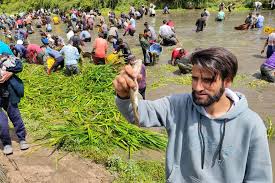In a quiet corner of South Kashmir, where snow-fed springs once sustained generations, a small village is reviving its waters the old-fashioned way: with hands, heart, and heritage.
Each year, as spring unfurls across the valley, dozens of villagers gather not for celebration in the conventional sense, but for something far more elemental — the cleansing of their rivers and springs. With rolled-up trousers and tools in hand, they descend into the cold, gurgling waters to remove weeds, sediment, and accumulated waste. What unfolds is not just a clean-up drive, but a community-wide ritual — one that renews both the environment and the village’s deep cultural identity.
The tradition, rooted in oral history and seasonal rhythms, is led by elders but embraced by all. Children, too, wade in, learning from their grandparents how to treat nature not as a resource, but as kin. Alongside the physical labor, there are rituals — local prayers, folk songs, and shared meals — that transform the day into a living festival of harmony between people and place.
At a time when the world debates sustainable development and environmental policy, this village offers a quiet, enduring example of grassroots conservation. There is no funding, no formal planning, and no publicity — only purpose.
“These springs are part of who we are,” says Abdul Latif, a retired schoolteacher who has participated in the ritual for over five decades. “If the water dies, so does the memory of our ancestors.”
For Kashmir, a region beset by both environmental vulnerability and political volatility, such practices are more than symbolic. They represent resilience — of people, of tradition, and of the natural world they refuse to abandon.


